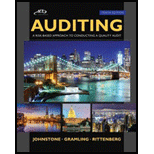
Auditing: A Risk Based-Approach to Conducting a Quality Audit
10th Edition
ISBN: 9781305080577
Author: Karla M Johnstone, Audrey A. Gramling, Larry E. Rittenberg
Publisher: South-Western College Pub
expand_more
expand_more
format_list_bulleted
Question
Chapter 7, Problem 17MCQ
To determine
Introduction: The directional relationships between the concepts of inherent risk, control risk, audit risk, and detection risk.
To choose:The option which best defines the relationship between inherent risk and audit risks.
Expert Solution & Answer
Want to see the full answer?
Check out a sample textbook solution
Students have asked these similar questions
Which of the following is a correct? Select one: a. Planned detection risk and inherent risk have an inverse relationship. b. All of the above are correct relationships. c. Acceptable audit risk and planned detection risk have an inverse relationship. d. Control risk and planned detection risk have a direct relationship.
Which of the following risks does the auditor least control? a. inherent risk b. control risk c. detection risk d. all are equally controllable
The combination of inherent risk and control risk constitutes :
A.
Occurence risk
B.
Audit risk
C.
Detection risk
D.
Combined risk
Chapter 7 Solutions
Auditing: A Risk Based-Approach to Conducting a Quality Audit
Ch. 7 - Prob. 1TFQCh. 7 - Prob. 2TFQCh. 7 - Prob. 3TFQCh. 7 - Prob. 4TFQCh. 7 - Prob. 5TFQCh. 7 - Prob. 6TFQCh. 7 - Prob. 7TFQCh. 7 - Prob. 8TFQCh. 7 - Prob. 9TFQCh. 7 - Prob. 10TFQ
Ch. 7 - Prob. 11TFQCh. 7 - Prob. 12TFQCh. 7 - Prob. 13TFQCh. 7 - In terms of the timing of the risk response, the...Ch. 7 - Prob. 15MCQCh. 7 - Prob. 16MCQCh. 7 - Prob. 17MCQCh. 7 - Prob. 18MCQCh. 7 - Prob. 19MCQCh. 7 - Prob. 20MCQCh. 7 - Prob. 21MCQCh. 7 - Prob. 22MCQCh. 7 - Prob. 23MCQCh. 7 - Prob. 24MCQCh. 7 - Prob. 25MCQCh. 7 - Prob. 26MCQCh. 7 - Prob. 27MCQCh. 7 - Prob. 28MCQCh. 7 - Prob. 29RSCQCh. 7 - Prob. 30RSCQCh. 7 - Define the following terms: (a) performance...Ch. 7 - Prob. 32RSCQCh. 7 - Prob. 34RSCQCh. 7 - Prob. 35RSCQCh. 7 - Prob. 36RSCQCh. 7 - How does inherent risk relate to internal...Ch. 7 - Prob. 38RSCQCh. 7 - Prob. 39RSCQCh. 7 - Prob. 40RSCQCh. 7 - Prob. 43RSCQCh. 7 - Prob. 45RSCQCh. 7 - Prob. 46RSCQCh. 7 - Prob. 47RSCQCh. 7 - Prob. 48RSCQCh. 7 - Prob. 49RSCQCh. 7 - Prob. 52RSCQCh. 7 - Prob. 53RSCQCh. 7 - Prob. 54RSCQCh. 7 - Prob. 55RSCQCh. 7 - Prob. 56RSCQCh. 7 - Prob. 57RSCQCh. 7 - Prob. 58FF
Knowledge Booster
Similar questions
- The audit risk model consists of: AR = IR x CR x DR. The detection risk is the dependent variable. What is the acceptable level of detection risk if the assessed level of inherent risk is HIGH and the control risk is MEDIUM? Group of answer choices a.Lower b.Medium c.Lowest d.Higherarrow_forwardThe risk of material misstatement is composed of which audit risk components?a. Inherent risk and control risk.b. Control risk and detection risk.c. Inherent risk and detection risk.d. Inherent risk, control risk, and detection risk.arrow_forwardThe audit risk model consists of: AR = IR x R x DR. The detection risk is the dependent variable. What is the acceptable level ofdetection risk if the assessed level of inherent risk is HIGH and the control risk is MEDIUM? a. Higher b. Lower c. Lowest d. Mediumarrow_forward
- Which of the following is appropriate about risk assessment? A. The assessed level of inherent and control risk can be sufficiently low, thus resulting to eliminating the need for substantive tests. B. Audit risk may be more effectively determined by assessing inherent and control risk separately. C. Detection risk is eliminated if an auditor were to examine 100 percent off the account balance or class of transactions. D. There is an iverse relationship between detection risk and the combined level of inherent and control riskarrow_forwardIn Auditing, which aspect is riskier, Completeness, or Existence?arrow_forwardUsing your knowledge of the relationships among acceptable audit risk, inherent risk, control risk, planned detection risk, performance materiality, and planned evidence, state the effect on planned evidence (increase or decrease) of changing each of the following factors, while the other factors remain unchanged. an increase in acceptable audit risk ________ an increase in inherent risk ________ a decrease in control risk ________ an increase in planned detection risk ________ an increase in performance materiality ________arrow_forward
- What is the audit risk model? Explain the elements of the modelarrow_forwardWhich of the following is not one of the five key steps within the ERM process? a. Risk response b. Risk acceptance c. Risk monitoring d. Risk identificationarrow_forwardWhich of the following is driving the need for assurance maps?a. Risk managers.Incorrect. b. Board members. c. Internal auditors. d. Compliance practitioners.arrow_forward
arrow_back_ios
arrow_forward_ios
Recommended textbooks for you
 Auditing: A Risk Based-Approach to Conducting a Q...AccountingISBN:9781305080577Author:Karla M Johnstone, Audrey A. Gramling, Larry E. RittenbergPublisher:South-Western College Pub
Auditing: A Risk Based-Approach to Conducting a Q...AccountingISBN:9781305080577Author:Karla M Johnstone, Audrey A. Gramling, Larry E. RittenbergPublisher:South-Western College Pub Auditing: A Risk Based-Approach (MindTap Course L...AccountingISBN:9781337619455Author:Karla M Johnstone, Audrey A. Gramling, Larry E. RittenbergPublisher:Cengage Learning
Auditing: A Risk Based-Approach (MindTap Course L...AccountingISBN:9781337619455Author:Karla M Johnstone, Audrey A. Gramling, Larry E. RittenbergPublisher:Cengage Learning

Auditing: A Risk Based-Approach to Conducting a Q...
Accounting
ISBN:9781305080577
Author:Karla M Johnstone, Audrey A. Gramling, Larry E. Rittenberg
Publisher:South-Western College Pub

Auditing: A Risk Based-Approach (MindTap Course L...
Accounting
ISBN:9781337619455
Author:Karla M Johnstone, Audrey A. Gramling, Larry E. Rittenberg
Publisher:Cengage Learning